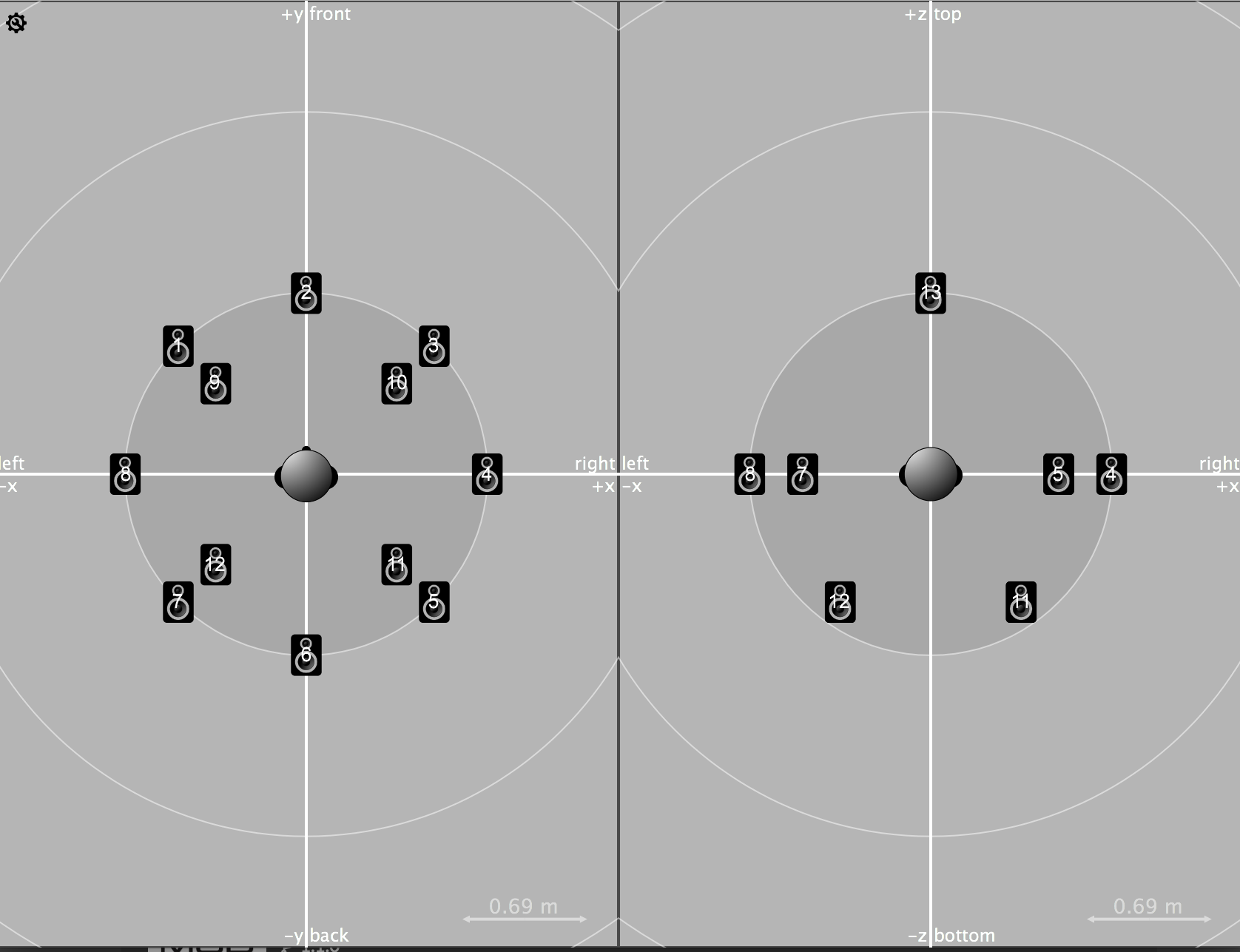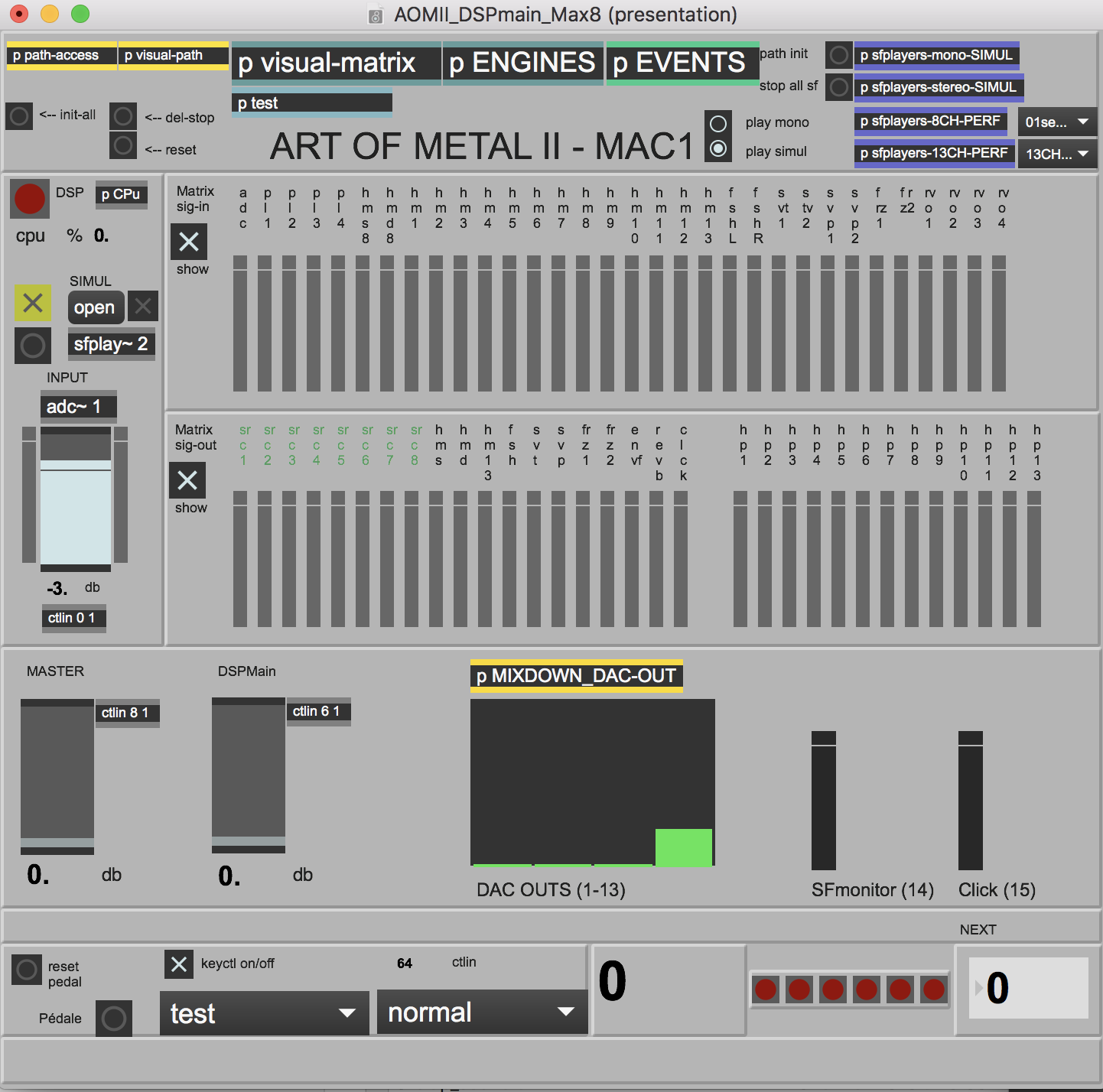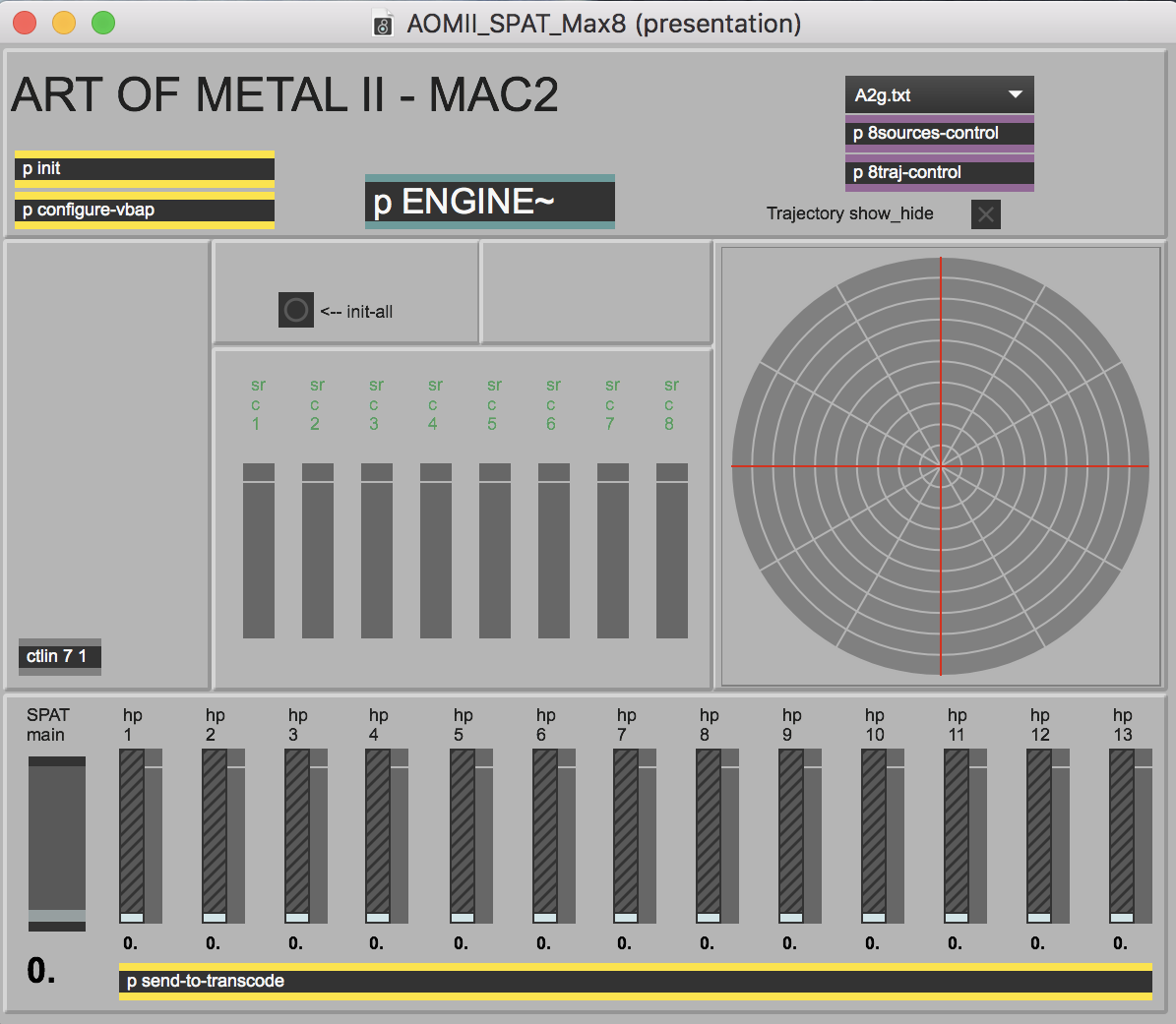Table of contents
Documentation date: 3 mars 2020
Version state
Valid
Validation date: 17 décembre 2020
Version documentalist
- muller (Augustin.Muller@ircam.fr)
Version realisation
- Charles Bascou (Computer Music Designer)
- Augustin Muller (Computer Music Designer)
Version length
11 mnUpgrade Motivation
Portage Charles Bascou
2 projects in the same Max 8 app.
64 bits
Spat5
No mxj
scalable output format
Comment
updated version, not tested in concert.
Other version(s)
- Yann Robin - Art of Metal II - AOM2 Moscou
- Yann Robin - Art of Metal II - Vuitton
- Yann Robin - Art of Metal II - 40ans EIC (no cut)
- Yann Robin - Art of Metal II - 40ans EIC
- Yann Robin - Art of Metal II - AOM2 Lille-2016
- Yann Robin - Art of Metal II - venise 2013
- Yann Robin - Art of Metal II - Venise-2011
- Yann Robin - Art of Metal II - strassburg
- Yann Robin - Art of Metal II - transfert_mustica_ftp
Detailed staff
- clarinette contrebasse
Channel details
- Number of input channel : 1
- Number of output channel : 13
Electronic equipment list
Computer Music Equipment
-
2 MacBook Pro - Apple Laptops
(Apple)
1 main, 1 spare (if main fails) -
1 Max 8 - Max
(Cycling74)
-
2 Fireface 800 - Sound Board
(RME)
1 for the main computer , 1 for the spare computer -
1 footswitch control - MIDI Controllers
(MIDI Solution)
to convert the pedal to MIDI -
1 Footswitch / Sustain Pedal - Footswitch / Sustain Pedal
for the clarinetist to trigger the cues -
1 MIDI booster - Booster
to send the MIDI pedal to the back of the room (and split)
Audio Equipment
-
1 Microphone - Microphone
"overhead" above the clarinet -
2 DPA 4021 - Condenser Microphones
(DPA)
on both sides of the instrument
Work related information
Premiere
- 2 octobre 2007, Paris, Ircam, Espace de projection, concert Cursus
Publisher :
- Jobert
Realisation
- Jean Lochard
- Yann Robin
Work length
- 11 mn
Useful links on Brahms
- Art of Metal II pour clarinette contrebasse métal et dispositif électronique (2007), 11mn
- Yann Robin
| File | Author(s) | Comment | |
|---|---|---|---|
| Download [10,3 Mio] | Simulation files Test files | A. Billard | audio files for testing |
| Download [450,2 Kio] | Score Score | Y. Robin | Ed. Jobert |
| Download [475,2 Mio] | All-in-one AOM2_2020_Port |
Instructions
IMPORTANT INFO
This version includes the performance AUDIO FILES with 8 CHANNELS ONLY & 13 channels only. The original version includes some simulation sound files (mono or stereo). If you need those, download a previous version of the piece!
Audio setup :
• 1 Live Audio input (mixdown of the clarinet mics) goes to main DSP patch.
• Up to 13 audio outputs for speakers (original version) + 1 sfiles monitor + 1 optionnal click track Output mixdown is possible in the main patch for configurations with less speakers.
MAIN DSP PATCH IO :
- 1 Mic Input
- 15 outputs + Sends
* 1-13 => speakers 1 to 13 /Scalable
* L-C-R SideR-SurR-SurC-SurL-SideL-DownL-DownR-DownSurR-DownSurL-Top / Scalable
* 14 => Sf Monitor (unused)
* 15 => optionnal click track
SPAT PATCH
- 8 receive Input from DSP patch:
- 13 outputs sends to Main DSP :
* 1-13 => speakers 1 to 13
* L-C-R SideR-SurR-SurC-SurL-SideL-DownL-DownR-DownSurR-DownSurL-Top
the original speaker layout still used for the trajectories & premix before pixdown is as follows :

Mic Setup
several microphones are needed to capture the sound of the clarinet.
For the top microphone, pavillion, we used an extra dynamic microphone (beyer M88) processed in a way to get a kick)like effect on the low C (Bb) slaps, using gate, resonnant lowpass (40Hz) and compressor. The sensation of these slaps must be physical, almost like a kick bass drum.
Loudspeaker setup
Up to 13 speakers :L-C-R SideR-SurR-SurC-SurL-SideL-DownL-DownR-DownSurR-DownSurL-Top
18 inches subs are required.
Midi setup
The clarinetist triggers the cues of the score/patch with a foot pedal sent in MIDI to the computer. When an analog footswitch or sustain pedal is used (as it was the case in this version) it needs to be converted to MIDI with a MIDI Solutions Footswitch Controller. If the console and computers are far away from the stage, a MIDI Booster is used to reinforce the MIDI transmission. It is used to duplicate the MIDI info for main and spare computers. You may control the levels of the Input, the Main DSP output, the Spatialization Output and the Master by a fader controller.
Software
You need one instance of Max 8. You may enable 'Enable Mixer in Parallel Processing'
This version is composed of two Max Projects:
AoMII_DSPMain_Max8.maxproj
AoMII_SPAT_Max8.maxproj
Except for the routing, no special Max setup is required for this piece. We use this standard setup :
- I/O Vector Size: 512
- Signal Vector Size: 256
- Sampling Rate: 48000Hz
- Scheduler in Overdrive: yes
- in Audio Interrupt: no
System calibration and tests
The input level should be set rather high for the effects to work properly.
Two soundfiles can be used as a simulation to quickly test the patch without the clarinetist. CLCB-sectA_05-diff.aifis a recording of the first 28 bars of the piece. CLCB-sectB-37_49-diff.aif is a recording of the bars 37 to 49.
You may need to adapt the mixdown for a particular setup different from the original 13 points layout. For this, have a look at the mixdown subpatch in the dsp_main. Adapt the spat5.pan~, spat5.meter~ to your number of outputs and configure correctly the viewer and the panning law. No other adjustment should be necessary for the spatialization.

Initialization routine
When launching the two projects, you can check for errors in the Max window.
Once you have loaded both projects:
- Start the audio with the red LED
Dac on/off. You can check that the CPU pourcentage near this LED is changing.
- Then
init-allwith the button of the Main.
- Check for errors , if you get an error from ambicontrol, try to re-do 'init-all'
- Pass one or two cues with your right arrow key (->)
- Then re
init-allwith the button of the Main
- Don't forget to check the input faders of both Max patches.
- For the pedal of the performer to actually trigger the cues, the mode menu should be set to
useinstead oftest

Patch presentation
• The DSP main patch interface:

This patch handles the sound fx,the soundfiles, the score & transport. The Input levels, Fx levels and master out are followed here (by mici ccs). It is the main audio inputoutput. It sends and receives audio wiith the spat patch.
• The SPAT (spatialization) main patch interface:

This handles all the trajectories. Be sure that they are correctly loaded (sources should visually move with concerned events)
The level of the spat is followed here (by midi CC 7). The audio is sent back to the main patch.
Performance notes
In general, Yann Robin likes when the sound coming from the computer is loud in the room! Adjust the volume consequently!
- The first sound of the electronics, triggered at the first note of the performer should be really impressive in the room, like a scream. This effect is mosly given by the Spat patches out
- From cue 11, the electronics is much quiter then grow again progressively. Keep this as a rather long crescendo in the electronics, don't push up the volume directly.
- At the end, the last section of slaps (pedal 44 to 45), the electronics have to be quieter and distant.
© IRCAM

This documentation is licensed under a Creative Commons Attribution-NonCommercial-NoDerivatives 4.0 International License.
Program note
_Art of métal II_, pour clarinette contrebasse métal et dispositif électronique en temps réel s’inscrit dans le cadre d’un cycle pour cet instrument et est le résultat d’une collaboration avec Alain Billard, clarinettiste et soliste de l’Ensemble intercontemporain. La [work:20852][première pièce du cycle], créée le 28 janvier dernier, confronte l’instrument à un ensemble de dix-sept musiciens, celle-ci à un dispositif électronique et la dernière, [work:20856][Art of métal III], en tant que synthèse, ralliera l’instrument à l’ensemble et à l’électronique. Elle sera créée en 2008\. Le fil d’Ariane de ce projet, l’idée conductrice, est une approche métaphorique de ce que peut inspirer le métal, cet alliage souvent synonyme de force, puissance, solidité, énergie, brillance, éclat etc. L’instrument lui-même est métallique dans son intégralité ; un bec en métal a spécialement été fabriqué pour l’occasion par Selmer pour remplacer celui qui est habituellement en ébonite. Outre la recherche de puissantes sonorités métalliques, l’autre préoccupation principale est le son que peut produire l’émission de la voix dans la clarinette contrebasse. Ce mixage engendre des perturbations et modifie considérablement le timbre de l’instrument. La voix est utilisée chantée ou bien criée. Ces cris, émis avec des sons fendus, amplifient la distorsion et la saturation du son, les timbres semblent éclater, exploser et produisent une violente énergie. Tout cela est accru par l’électronique, qui immerge l’auditeur à l’intérieur même du son grâce à un système de spatialisation permettant de modifier virtuellement les paramètres acoustiques d’une salle et donc d’en changer psychoacoustiquement la perception. D’autres outils de traitements développés à l’Ircam, donnant la possibilité de resynthétiser le son en temps réel, d’en extraire le « bruit » ou les transitoires d’attaques, ont apporté une précieuse contribution et enrichi considérablement l’univers sonore de ce projet.Yann Robin.
Version documentation creation date: 3 mars 2020 17:04, update date: 10 septembre 2021 10:43